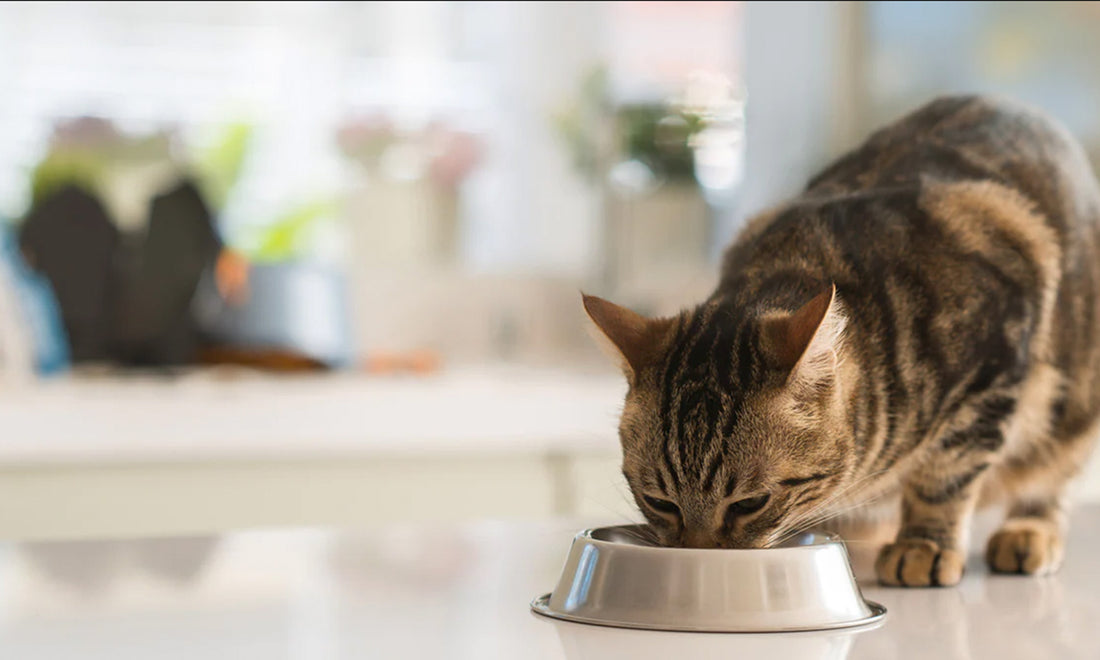
Sandy Robins answers your top questions on cat eating habits
Tips on Cat Eating Habits and Health
The maxim“you are what you eat”certainly applies to our pets too. The key to good health is balanced nutrition and our cats need to count calories and exercise just like their pet parents. We received many emails on this topic and address some of them here.
How do I get my cat to eat more slowly and stop begging for food?
 There are special “slow bowls” designed to make pets eat more slowly. Better still, take her food and hide it in the compartments of a specially designed cat puzzle. This way she will really have to work for her food. This action will not only slow her down but will also offer the added benefits of both mental and physical stimulation. Also, consider investing in an automatic kibble dispenser. Her food allowance for the day can be divided into mini-meals and dispensed throughout the day. Cats can be very opportunistic and feel they are entitled to share your meals too. To stop her begging, don’t give in and give her tidbits. It will only encourage her to keep this up! Instead, set up a fixed time for a daily treat. Something for her to look forward to. Next, she will be waiting in front of the treat cupboard or draw for her daily snack. But that’s okay. Make her sit and wait for it. To do this, hold the treat over her head so she is forced into a sitting position. Say “sit” while she assumes and holds this position. Then, give her the tasty reward. Cats are smart and fast learners. This is also a great way to enhance the human-animal bond.
There are special “slow bowls” designed to make pets eat more slowly. Better still, take her food and hide it in the compartments of a specially designed cat puzzle. This way she will really have to work for her food. This action will not only slow her down but will also offer the added benefits of both mental and physical stimulation. Also, consider investing in an automatic kibble dispenser. Her food allowance for the day can be divided into mini-meals and dispensed throughout the day. Cats can be very opportunistic and feel they are entitled to share your meals too. To stop her begging, don’t give in and give her tidbits. It will only encourage her to keep this up! Instead, set up a fixed time for a daily treat. Something for her to look forward to. Next, she will be waiting in front of the treat cupboard or draw for her daily snack. But that’s okay. Make her sit and wait for it. To do this, hold the treat over her head so she is forced into a sitting position. Say “sit” while she assumes and holds this position. Then, give her the tasty reward. Cats are smart and fast learners. This is also a great way to enhance the human-animal bond.
Why does my cat throw up after eating?
 One of the reasons she is throwing up may be because she is eating too fast. So, try slowing her down with some of the suggestions offered above. However, she may also have a food intolerance to the main protein in her meals. Typically, the symptoms are digestive upsets such as a bloated tummy or gas as well as vomiting, bigger than normal stools, more frequent stools, or even runny stools. Try serving another flavor (protein) of pet food. But it’s very important to read labels and ensure that you are eliminating all the main protein sources that your pet has been eating. For example, if you have been serving a chicken formula, you need to switch to a formula that contains neither chicken nor chicken meal. Single-ingredient pet foods have made it much easier for pet parents to switch over. A single ingredient pet food has only one protein source as the “single-ingredient”. Look for a protein that your pet has never had before such as duck or venison. Nevertheless, it’s important to read the label to see what other ingredients are in the equation too. It’s a really good idea to do a food switch under veterinary supervision because no one understands your pet’s general health and specific medical issues like your pet’s veterinarian.
One of the reasons she is throwing up may be because she is eating too fast. So, try slowing her down with some of the suggestions offered above. However, she may also have a food intolerance to the main protein in her meals. Typically, the symptoms are digestive upsets such as a bloated tummy or gas as well as vomiting, bigger than normal stools, more frequent stools, or even runny stools. Try serving another flavor (protein) of pet food. But it’s very important to read labels and ensure that you are eliminating all the main protein sources that your pet has been eating. For example, if you have been serving a chicken formula, you need to switch to a formula that contains neither chicken nor chicken meal. Single-ingredient pet foods have made it much easier for pet parents to switch over. A single ingredient pet food has only one protein source as the “single-ingredient”. Look for a protein that your pet has never had before such as duck or venison. Nevertheless, it’s important to read the label to see what other ingredients are in the equation too. It’s a really good idea to do a food switch under veterinary supervision because no one understands your pet’s general health and specific medical issues like your pet’s veterinarian.
My cat is overweight. How do I get him to lose weight?
 It may not sound a lot in human terms, but a cat can be considered overweight by weighing an additional two pounds according to her size and build. So, cats need to count calories too! However, if your pet is really overweight and possibly even clinically obese, there are science-based weight control diets. Your veterinarian can help plan an ideal weight reduction program. Never guess or drastically reduce serving amounts for yourself as under-feeding is as dangerous as over-feeding! For starters, read the label on the food you are currently serving to check the fat content and the calories per cup. They differ per recipe. And, to see if you are over-feeding, take my Kitchen Counter Quiz: When you measure food:
It may not sound a lot in human terms, but a cat can be considered overweight by weighing an additional two pounds according to her size and build. So, cats need to count calories too! However, if your pet is really overweight and possibly even clinically obese, there are science-based weight control diets. Your veterinarian can help plan an ideal weight reduction program. Never guess or drastically reduce serving amounts for yourself as under-feeding is as dangerous as over-feeding! For starters, read the label on the food you are currently serving to check the fat content and the calories per cup. They differ per recipe. And, to see if you are over-feeding, take my Kitchen Counter Quiz: When you measure food:
-
When you measure food:
A. Do you do use a standard measuring cup?
or
B. Grab the closest cup or mug of any shape or size in the cupboard?
-
When you fill the cup with kibble:
A. Do you ensure the food is level with the top?
Or
B. Do you heap it up as much as you can?
If you answered B to both questions, without realizing it, you are over-feeding your pet!Further, if you scoop off the heaped amount into a measuring cup, it’s easy to see by how much you are overfeeding at each meal. And it really adds up. So, start by serving only level cups of food. Treats have calories too! They should account for 10% or less of the total daily caloric intake. Never in addition to the daily food amount.Increase daily exercise with wand games, laser toys, and move the food bowl a fair distance from a popular snooze zone so that a walk-in involved at mealtimes. Dieting a cat is a very slow process. But it’s so worth it to extend her longevity and avoid very serious health issues.
Why does my cat eat plastic? How do I get him to stop?
 Eating plastic and chewing on wool are very common and considered signs of obsessive-compulsive disorders in cats. Typically, it starts with kittens that were too young when removed from their mothers and not given the opportunity to nurse properly until weaned; they compensate by sucking on materials.It can also be induced by boredom and loneliness. Ingestion of materials such as plastic is very dangerous. Cat-proof your home as you would for a toddler. Be sure never to leave plastic bags, bubble wraps, string, and ribbons accessible. You can read more about this topic and how to fix here.
Eating plastic and chewing on wool are very common and considered signs of obsessive-compulsive disorders in cats. Typically, it starts with kittens that were too young when removed from their mothers and not given the opportunity to nurse properly until weaned; they compensate by sucking on materials.It can also be induced by boredom and loneliness. Ingestion of materials such as plastic is very dangerous. Cat-proof your home as you would for a toddler. Be sure never to leave plastic bags, bubble wraps, string, and ribbons accessible. You can read more about this topic and how to fix here.
To read more about your cats’ health and tips for making sure they are healthy and strong, read more in Skoon blogs.

